I'd say that it certainly is consequential, if you're looking to produce 16 Hz and any appreciable volume.
The problem is not technical... which is easily tweaked even if any of these theoretical anxieties are partially realized.
The problem is people telling Bach On to open his new expensive gear and solder in new components. That's [edited by author].
C'mon now, let's make it happen by providing positive guidance, not picky stuff.
Ben
Last edited:
Yep. I'm bad.
Modify something so that it work's the way you intended, not the way they ship it.
On the other hand, if that is a problem, and a it certainly could be. A person can spend a bit more and get a product that will not require any modification. If suggestions are needed I can post a few.
I have the schematic for the Roll's MB15b and I'm attempting to do a spice simulation to see what the actual roll offs are. I haven't done that in so long I don't even remember when.
By the way, who is that beside Bach?
Modify something so that it work's the way you intended, not the way they ship it.
On the other hand, if that is a problem, and a it certainly could be. A person can spend a bit more and get a product that will not require any modification. If suggestions are needed I can post a few.
I have the schematic for the Roll's MB15b and I'm attempting to do a spice simulation to see what the actual roll offs are. I haven't done that in so long I don't even remember when.
By the way, who is that beside Bach?
Last edited:
The problem is not technical... which is easily tweaked even if any of these theoretical anxieties are partially realized.
The problem is people telling Bach On to open his new expensive gear and solder in new components. That's [edited by author].
C'mon now, let's make it happen by providing positive guidance, not picky stuff.
Ben
I think the issue here is trying to use equipment for a purpose it wasn't initially designed for in the first place.
Pro audio equipment AFAIK is not usually designed with producing 16 Hz in mind. In fact, it could be dangerous to speakers if it was. One dropped mic and...
However, if that's what the poster has, and it can be safely modded accordingly, then why not do so?
Yep. I'm bad.
Modify something so that it work's the way you intended, not the way they ship it.
On the other hand, if that is a problem, and a it certainly could be. A person can spend a bit more and get a product that will not require any modification.
I have the schematic for the Roll's MB15b and I'm attempting to do a spice simulation to see what the actual roll offs are. I haven't done that in so long I don't even remember when.
By the way, who is that beside Bach?
Didn't mean to make it personal. But... differences in pro versus home levels and balanced versus not are pretty minor unless your signal wires are very long and near a TV broadcast antenna. Half this forum is using a Behringer (such as the fabulous DCX2496) and needs just a hint of gain management to work perfectly and keep well off the noise floor.
what if some component says it protects speakers below 30 Hz. That means they installed a large very, very, very loosely rated capacitor with a nominal value that starts to operate around 20 Hz, maybe, and cuts at 3 dB/8ave. Big deal. Certainly no reason to alarm Bach On. Not sensible.
As for 6-7 dB, when I get to heaven, I'm going to ask for a room with less that a plus and minus 20 dB room modes 'cuz I've never found one on earth. 6 dB is detectable in close comparisons, but hardly a big thing AT THIS stage of R&D.
Anyway, I provided a $12 way to check signal levels right at the speaker terminals. (Bach On - set voltmeter to AC and volts NOT amps. Any voltmeter at any price and digital or analog will work fine.) Testing your gear is crucial. Fretting over theoretical problems is not.
Ben
Last edited:
@ mwmkravchenko
I already simmed the Roll's MB15b with Multisim, that's why i posted the capacitor change suggestions needed. But be interested to see what you sim too.
I already simmed the Roll's MB15b with Multisim, that's why i posted the capacitor change suggestions needed. But be interested to see what you sim too.
I didn't take it personally. Tongue firmly in cheek.
The simplest thing to remember is that you need some gain, and you need it fairly wideband. Having a volume knob and nice enclosure with the proper inputs and outputs is a plus.
The Rolls box is definitely setup to safeguard a pro-audio system. And a little application of ingenuity will make it what is required. Or when it arrives ship back and get something that is not needing a helping hand off the get go.
The simplest thing to remember is that you need some gain, and you need it fairly wideband. Having a volume knob and nice enclosure with the proper inputs and outputs is a plus.
The Rolls box is definitely setup to safeguard a pro-audio system. And a little application of ingenuity will make it what is required. Or when it arrives ship back and get something that is not needing a helping hand off the get go.
@ mwmkravchenko
I already simmed the Roll's MB15b with Multisim, that's why i posted the capacitor change suggestions needed. But be interested to see what you sim too.
I'm reading the SPICE manual now!
It is sad how rusty things become when you don't work with them for a long time.
You almost made me fall off of my chair laughing. I'll try and get it up and running in fairly short order.
By the way, Mark works just fine.
By the way, who is that beside Bach?
Just some old coot who gets miffed when he runs into engineering-wannabees who think T/S sims encapsulate the whole of audio design.
Ben
@ Mark 😉
Laugh @ what ?
SPICE boys - SPICE men 😀 Like riding a bike i expect, once you know how to it'l no doubt all come back to you fairly quickly 😉
Laugh @ what ?
SPICE boys - SPICE men 😀 Like riding a bike i expect, once you know how to it'l no doubt all come back to you fairly quickly 😉
The problem is not technical... which is easily tweaked even if any of these theoretical anxieties are partially realized.
Again, you either didn't read or didn't comprehend what I posted. This is not theoretical anxieties, I showed two graphs of MEASUREMENTS showing the real world rolloff of these DI boxes, one was the Cleanbox the other was the Rolls. It CLEARLY shows a loss of 6 or 7 db at 16 hz.
These are not hand drawn pictures someone drew to upset you, they are real measured response of these units.
You've made your contempt for OP's goal of strong 16 hz very clear by suggesting that nobody can actually hear it, it isn't important, suggesting that a leak in the box is unimportant, and your myriad other suggestions and recommendations like the ludicrous Klipschhorn and sealed box recommendations. That doesn't change the fact that OP DOES have a goal and most of us here are actually trying to help him accomplish it.
The problem is people telling Bach On to open his new expensive gear and solder in new components. That's [edited by author].
C'mon now, let's make it happen by providing positive guidance, not picky stuff.
Ben
I told him before he bought anything to research and buy the right product. He didn't, and now this is where we are.
This is not picky stuff, there's about a thousand threads on this issue at avsforum where guys routinely try to get flat response to single digit frequencies at reference levels, usually using prosound gear. If every piece of equipment in your signal chain rolls off a few db, it becomes incredibly hard to get flat response to low frequencies.
You need to use the right tool for the job, or modify the tool so it becomes the right tool for the job. Your constant suggestions of things that can't possibly achieve OP's stated goals show clearly that you don't know how to make it happen and personally disagree with the goal itself.
what if some component says it protects speakers below 30 Hz. That means they installed a large very, very, very loosely rated capacitor with a nominal value that starts to operate around 20 Hz, maybe, and cuts at 3 dB/8ave. Big deal. Certainly no reason to alarm Bach On. Not sensible.
Again, look at the info I posted. Your assessment of this situation shows a complete lack of understanding of what's going on here. The DI box is rolling off already at 100 hz, it's not a filter that starts to operate at 20 hz.
As for 6-7 dB, when I get to heaven, I'm going to ask for a room with less that a plus and minus 20 dB room modes 'cuz I've never found one on earth. 6 dB is detectable in close comparisons, but hardly a big thing AT THIS stage of R&D.
Again, the WHOLE GOAL here, reflected in the name of this thread is 16 hz. As Weltersys pointed out, 5 db at low frequencies relates to a perceived doubling of volume. Suggesting that 6 db is not detectable or not important at ANY stage of R&D again shows ignorance of the subject matter and contempt for the goal. There's only one goal. It's 16 hz at high levels.
Just some old coot who gets miffed when he runs into engineering-wannabees who think T/S sims encapsulate the whole of audio design.
Ben
This all goes so far beyond simulations. We've been talking about sealed vs ported, leaks in boxes, measured response of equipment, resonances, how horns work, how to make an "audiophile" approved ported box and a ton of other stuff. The sims for this project were presented months ago and not really mentioned since. Unfortunately you weren't able to provide anything but a cursory uneducated opinion on any of these topics and refused to discuss any of it in technical terms but I've provided a TON of info to back up every thing I've said.
As such, it's a bit frustrating when you come in with your "audiophile" buzzwords, catchphrases and themes without a shred of evidence to back up any of your bizarre recommendations. I really don't enjoy being hard on you Ben, but you show an appalling lack of scientific rigor and a huge amount of uninformed opinion.
Ben,
I think all you have to do is remember my ID to get a sense of who I listen to the most. 😉
Zero D and Mark, you both suggested capacitor changes for the Rolls unit. But Zero D suggested more capacitors should be changed.
The ART unit would require one capacitor change for each channel.
Now there is even a question as to whether the Crown XLS1500 might have a roll-off that would reduce the low output to the speaker.
But a thought keeps coming to my mind: I intend to use the amp and speaker for one primary purpose - to reproduce sounds from the Artisan Sound Engine. The Artisan package allows for note-by-note adjustments in volume level for each rank - including those going down to 16 Hertz. I'm only trying to run consumer grade equipment through the equipment for testing.
Just a Guy, it is true that I didn't do much research on this latest piece of equipment. But I have ordered something that should be able to do what is needed for testing with some relatively minor modifications I feel I can do. Amazon just sent me e-mail to say the Rolls unit was shipped today and should arrive on Wed.
I went over today and applied the DAP caulk to seal the two sections of the triangular box. I also corrected the problem with the bridged wiring from the XLS to the speaker. I'm still hopeful that I will be able to run the XLS1500 in regular stereo mode so I can run the original bass box with the twin Dayton 15 inch woofers on one channel and this new triangular box on the other channel. If not, I'll probably have to buy another stronger amp.
I ran some tones and sweeps. I tried a measurement with REW. Just tried to upload it, but the attachment feature for this board says it is an invalid file type. It is a .mdat type. And suggestions on what I need to do to share the results here?
Bach On
I think all you have to do is remember my ID to get a sense of who I listen to the most. 😉
Zero D and Mark, you both suggested capacitor changes for the Rolls unit. But Zero D suggested more capacitors should be changed.
The ART unit would require one capacitor change for each channel.
Now there is even a question as to whether the Crown XLS1500 might have a roll-off that would reduce the low output to the speaker.
But a thought keeps coming to my mind: I intend to use the amp and speaker for one primary purpose - to reproduce sounds from the Artisan Sound Engine. The Artisan package allows for note-by-note adjustments in volume level for each rank - including those going down to 16 Hertz. I'm only trying to run consumer grade equipment through the equipment for testing.
Just a Guy, it is true that I didn't do much research on this latest piece of equipment. But I have ordered something that should be able to do what is needed for testing with some relatively minor modifications I feel I can do. Amazon just sent me e-mail to say the Rolls unit was shipped today and should arrive on Wed.
I went over today and applied the DAP caulk to seal the two sections of the triangular box. I also corrected the problem with the bridged wiring from the XLS to the speaker. I'm still hopeful that I will be able to run the XLS1500 in regular stereo mode so I can run the original bass box with the twin Dayton 15 inch woofers on one channel and this new triangular box on the other channel. If not, I'll probably have to buy another stronger amp.
I ran some tones and sweeps. I tried a measurement with REW. Just tried to upload it, but the attachment feature for this board says it is an invalid file type. It is a .mdat type. And suggestions on what I need to do to share the results here?
Bach On
Last edited:
I ran some tones and sweeps. Did a measurement. Just tried to upload it but the attachment feature for this board says it is an invalid file type. It is a .mdat type. And suggestions?
Bach On
Get the measurement on your screen. Print screen, paste into MS Paint. Crop and save as .png or .jpg or whatever. Upload to forum.
Ideally you should be measuring the box outside first. That will tell us if you hit your design goals, and if the measurement matches the sim. THEN you should have the box in place where it's going to live and measure from the listening position (or an average across the listening position). Any other measurement is going to be almost completely useless, as it won't identify if the box is built and operating properly and won't reflect what response will be at the listening position.
Zero D and Mark, you both suggested capacitor changes for the Rolls unit. But Zero D suggested more capacitors should be changed.
The ART unit would require one capacitor change for each channel.
If you are considering returning the Rolls there are units you can buy that don't need any modification. Like I said, research. Mark said he had a list, maybe you might consider that.
Last edited:
I ran some tones and sweeps. Did a measurement. Just tried to upload it but the attachment feature for this board says it is an invalid file type. It is a .mdat type. And suggestions?
Bach On
Wonderful.
If you view the basic screen ("SPL % Phase".... or better, "Distortion"), there's a little pictograph above the word "Capture" at upper left corner of the graph. I think the file that will be saved after you do that should be good to go.
It is nice to see the distortion curves* by just choosing that option as your first post.
Loudness or calibration are not important. Just play it loudish and tell us how many feet from the cone.
After you've run a few curves trying this and that (like moving mic from one hot-spot to another), just click on "Overlays" and you can select which couple you'd like to eyeball curve to curve. Then just click "Capture" again. Take care in using meaningful titles for files.
Ben
*ummm, hard to sim distortion
Last edited:
*ummm, hard to sim distortion
Simulators can't cook you breakfast or drive you to work either, that's not what they are made for. This is a ridiculous straw man argument. Simulators are EXTREMELY, outrageously good at what they were made to do. This has been proven thousands of times, a few times in this thread alone.
If you have a reasonable amount of experience with the enclosure type and driver type you already know what the distortion is going to be like anyway, assuming the box is built properly and accurately. If the enclosure or driver are broken, that will show up in distortion measurements, but it will also show up in all other measurements, FR, impedance, and everything else.
I'll meet you in the middle just a guy.
But without practical experience and real world reference a simulator can be utterly useless.
It is the garbage in - garbage out scenario.
Measurements are what keep everything real.
But without practical experience and real world reference a simulator can be utterly useless.
It is the garbage in - garbage out scenario.
Measurements are what keep everything real.
Measurements are what keep everything real.
Amen, brother.
Ben
Zero D hit the nail on the head. Correct Capacitor designations and correct values.
Aluminum Electrolytic Capacitors - Leaded | Mouser
Your looking at under $0.25 a piece.
The only thing I don't know is the lead spacing.
@ Master Zero D
Wish I could get me a signal into my sim.
It's been a long day. Started early with getting a few pigs of to Bacon and Pork chop land. I raise pigs and chickens as a hobby. Every set of pigs gets the same name. Bacon and Pork Chop. Tis what they end up as after all!
And plenty of wrestling with a very complicated horn design.
I will crack the SPICE nut tomorrow after reading the parts of the manual that mine eyes are a little to tired to do tonight.
@ Bach On
I tease those who can take it. The rest just run away .
The only way to know what the capacitor size is on the board is to measure the pin to pin distance on the back of the board. My guess is that they will be radial leaded. Two on one end. You will want to mark on the board which side has + and which side has -. Usually a black band up one edge is the negative terminal.
Don't ask what happens if you put them in backwards. It's starts with a really high pitched whine and a big shot gun type Kapow. Not admittin nuttin.
Aluminum Electrolytic Capacitors - Leaded | Mouser
Your looking at under $0.25 a piece.
The only thing I don't know is the lead spacing.
@ Master Zero D
Wish I could get me a signal into my sim.
It's been a long day. Started early with getting a few pigs of to Bacon and Pork chop land. I raise pigs and chickens as a hobby. Every set of pigs gets the same name. Bacon and Pork Chop. Tis what they end up as after all!
And plenty of wrestling with a very complicated horn design.
I will crack the SPICE nut tomorrow after reading the parts of the manual that mine eyes are a little to tired to do tonight.
@ Bach On
Har-de-har-har!!!
When is the tryout for your HBO comedy special scheduled?
BO
I tease those who can take it. The rest just run away .
The only way to know what the capacitor size is on the board is to measure the pin to pin distance on the back of the board. My guess is that they will be radial leaded. Two on one end. You will want to mark on the board which side has + and which side has -. Usually a black band up one edge is the negative terminal.
Don't ask what happens if you put them in backwards. It's starts with a really high pitched whine and a big shot gun type Kapow. Not admittin nuttin.
I'll meet you in the middle just a guy.
But without practical experience and real world reference a simulator can be utterly useless.
It is the garbage in - garbage out scenario.
Measurements are what keep everything real.
Of course, but does this even need to be mentioned? This was never in question. Is there anyone here that doesn't have at least a basic level of experience including measurements?
Also not in question - accurate sims match measurements within the well known limitations of the simulator used. Every time. There's mountains of evidence.
Last edited:
A few pictures. Oliver might want to see the finished product if he checks in from vacationland. I don't claim it is pretty, but I do think it is solid. I'm satisfied it weighs right at 200 pounds.
The front face is 26 inches wide and 73.5 inches high.
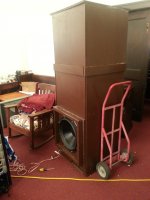
The plan is to use nylon window screen as a protective grill. Since the cone has a protruding rubberized surround, I felt a frame to keep the screen clear was needed. That's 2x4s sawn down to about 2 1/2 inches. The screen will be stretched tightly over these. I'm waiting to apply the screen until I'm a bit further along in the process in case I should need to remove the driver to do anything to the interior. Thus far, I hear to creaks or rattles.
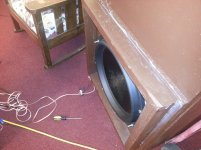
Here's the junction between the two parts of the cabinet. I put a liberal coat of temporary caulk to the boards at this joint. The top will be removed and this temporary caulking will be removed. When the cabinet is finally in place, I was planning to use plenty of PL Construction Adhesive to firmly join the two portions. I THINK that will adequately seal any leaks in the joint. If not, I may have to use some silicone caulking to get the last portions.
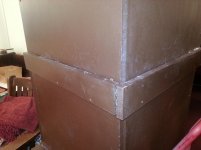
Here's the ART box I'm using for the Dayton mike.
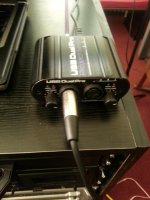
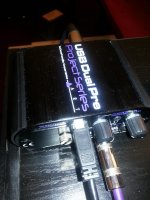
Bach On
The front face is 26 inches wide and 73.5 inches high.

The plan is to use nylon window screen as a protective grill. Since the cone has a protruding rubberized surround, I felt a frame to keep the screen clear was needed. That's 2x4s sawn down to about 2 1/2 inches. The screen will be stretched tightly over these. I'm waiting to apply the screen until I'm a bit further along in the process in case I should need to remove the driver to do anything to the interior. Thus far, I hear to creaks or rattles.

Here's the junction between the two parts of the cabinet. I put a liberal coat of temporary caulk to the boards at this joint. The top will be removed and this temporary caulking will be removed. When the cabinet is finally in place, I was planning to use plenty of PL Construction Adhesive to firmly join the two portions. I THINK that will adequately seal any leaks in the joint. If not, I may have to use some silicone caulking to get the last portions.

Here's the ART box I'm using for the Dayton mike.


Bach On
- Status
- Not open for further replies.
- Home
- Loudspeakers
- Subwoofers
- 16Hz for church organ